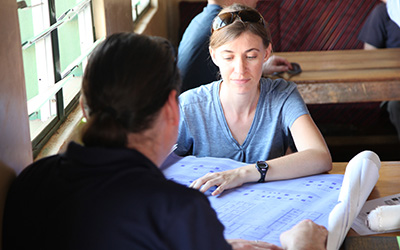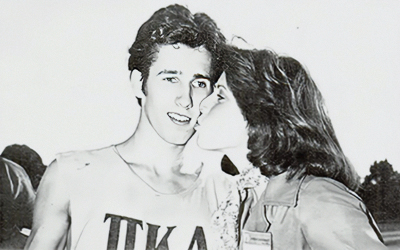By Todd Deery ’90
The Plainsmen of Pixels
Two alumni build Auburn’s campus in Minecraft
There are times when it’s just so funny.
When the absurdity of trying to do this crazy, stupid project that no one would do just bubbles over. That’s one thing Chris Smith ’09 loves about it. The nostalgia and the newness. The grunt work and the glitches. The confusion that comes from straddling two worlds at once.
Like the day he flew above an empty Auburn campus to a concession stand in the upper West deck of Jordan-Hare Stadium, only to find a random villager and two llamas.
Smith screenshotted the invaders and posted the picture on his @MCAubie Instagram page. He asked his followers what they thought they were doing there.
“Selling Dippin’ Dots for $10” came a reply.
Welcome to the Minecraft Auburn Project.

There are times when it’s the only thing that matters.
In 2011, Trey Long ’19 was a junior in high school when he first played Minecraft. It was two years after the release of the game and its popularity was obvious. Minecraft was started by a Swedish programmer named Markus “Notch” Persson. The game is a 3-D pixelated sandbox world where players can easily build, destroy and create using Minecraft’s basic currency, the building block.
The game has several modes, but Long immediately chose the creative mode, which gives you the full array of blocks and no enemies to battle. Although Minecraft allows you to build with others, he preferred building solo. He created replicas of his childhood Birmingham home and his church. He built train stations and skyscrapers. Even with Minecraft’s basic tools, Trey found he was skilled at recreating what he saw in real life.
So when he arrived at Auburn in fall 2012 with an ROTC scholarship and an electrical engineering degree mapped out, he looked at Samford Hall and saw nothing but digital building blocks.
Long created a single-player Minecraft map named “Auburn” on his computer. Using the Google Earth tool, he was able to get the dimensions of any structure in the world. With this information he created 10 campus buildings, including Samford, Langdon, Hargis, Biggin, Davis and Cater halls.
He posted videos of his progress on YouTube.
With his brother Jared Long ’19, he made a replica of Jordan-Hare Stadium, complete with :01 seconds on the scoreboard. He was nervous when he built it and the proudest when they finished.
“For weeks we worked on that stadium together,” Long said. “While we were working on it, we knew it would be cool.”
Then a funny thing happened to Long. Life. The real one. Between ROTC and the classes and homework and the time it takes to build all those buildings, he got burned out. Around 2015, he put the Auburn Minecraft Project down. Auburn’s campus remained a computerized construction site.
There are times when it seems all too perfect.
Like the timing of the phone call. Trey was burned out. Done, finished with the whole thing. Hadn’t touched it in a year? Two? Who knows?
While Long had forgotten Minecraft, the world had not. By 2015, it had exploded in popularity, in part through people like him posting videos of their builds on YouTube (to date, Minecraft-themed videos on YouTube have been viewed more than 1 trillion times). It crossed the threshold from game to phenomenon. Kids started wearing Minecraft Halloween costumes. There were toys and plush dolls and phone cases and a cartoon. The whole country of Denmark was recreated using the game! In 2014, Minecraft was purchased by Microsoft for $2.5 billion.
Meanwhile, Chris Smith had graduated from Auburn in graphic design, and even went to graduate school in 2005 to study game development. But he had no interest in Minecraft. His daughter Gianna did, however, and around 2016, they start playing on their own server, bonding over the building and discovery that’s baked into Minecraft’s digital DNA. And then she showed him some of Long’s videos and he decided he wants to be a part of this. He had to be a part of this. And so he called.
“Before Chris reached out, I wasn’t looking for help,” Long said. “But he had a vision of where we could take this and how we could finish. That was so energizing to me.”
One of the first big projects that Smith took on was not even a building. It was the Minecraft Auburn Project terrain. It was not like the real experience of walking Auburn’s rolling campus. Smith used GIS (Geographic Information System) servers to get accurate topography of the campus, built it out and then placed it in the world. At one point he pasted more than 1.2 million blocks into the file.
“I held my breath for about 30 minutes while it pasted,” he said.
There are times when it seems all too real.
Over the last three years, Smith has run the project and put the map on a server, which enables Long to help with construction. Smith built out the Twitter and Instagram accounts and gives their followers regular building updates.
Their recent projects have included Plainsman Park and the soon-tobe-demolished Hill dorms. They are opening the project to some selective builders. They want people to eventually be able to tour a 3-D replica of campus from anywhere in the world.
Could the two imagine building anything else? The answer is unequivocal.
“It’s Auburn or nothing,” said Smith. “I mean, I’m not going to spend this much time building my hometown. Neither is Trey. Auburn just means everything to everybody who’s ever been there. We wanted people who went to Auburn and loved it to be able to tour and not have to leave their house. You can get it on your Xbox. Or any PC or game console. That’s the dream.”
The Auburn world that Long and Smith have created is becoming so consistent and fleshed out that sometimes you can almost taste the tart lemons in the Toomer’s lemonade.
“We’re both very detail oriented. We want this to be ‘this is real, but it’s Minecraft,’” laughs Smith. “I was recently in the game taking some screenshots of the old art building. I’m [using the] zoom tool, which makes for real good pictures. So I back up into the street at Toomer’s Corner, and I literally take my finger off the zoom tool to look around and see if cars are coming.”
There are times when it just all works out.
For Long, the effect of Minecraft and Auburn on his life is hard to measure. This hits him full force when I ask what he’s doing these days for work.
“I am now a construction manager for a company out here in Atlanta building apartments,” Long said, laughing. “And I’m really happy. I wouldn’t have done it any other way. But yeah, it’s interesting that I built them virtually and now I’m doing it in real life.”
How To Make A Building in Minecraft


Using Google Earth Pro, get the dimensions of the outside of the building.

Put down a corner block. This is your cornerstone.

Start down one exterior wall. Note that each Minecraft block is a meter. Create a one- or two-block-high perimeter wall that matches the outline of the building.

Build all the way up to the roofline, wall by wall.

Note the location of any windows and doors and use blocks to recreate them.

Create the roof and roofline (Long uses stair blocks).

Put the floors down (Long says most floors are 5 Minecraft blocks high).

Put torches out for the lighting.
Building Hope: Disaster Relief Architecture & Design
Combining faith and design, disaster response architect Sarah Elizabeth Dunn ’03 builds shelters for disaster-stricken communities around the world.
Harold Franklin Reflects on Integration 50 Years Later
Fifty years ago, unsure of his safety, a tall, soft-spoken Black man walked alone across the Auburn campus to register for classes.
Auburn Love Stories: How They Met
From blind dates to football games to chance meetings in the classroom, Auburn alums reflect on how they found love and everlasting romance on the Plains.
Building Hope: Disaster Relief Architecture & Design
Combining faith and design, disaster response architect Sarah Elizabeth Dunn ’03 builds shelters for disaster-stricken communities around the world.
Harold Franklin Reflects on Integration 50 Years Later
Fifty years ago, unsure of his safety, a tall, soft-spoken Black man walked alone across the Auburn campus to register for classes.
Auburn Love Stories: How They Met
From blind dates to football games to chance meetings in the classroom, Auburn alums reflect on how they found love and everlasting romance on the Plains.


